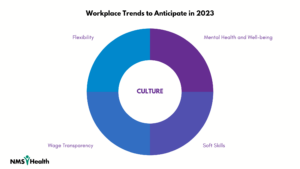It’s officially 2023. With a fresh start like a New Year, many people look to revamp their routines and set intentions for the year to come. Resolutions are not just for individuals; employers and their companies can benefit from setting fresh goals and improving. While employers begin to create their yearly roadmap, it is helpful to consider potential workplace trends for 2023.
To move forward in the new year, employers must first look back. After so many upheavals since the start of the pandemic, it is foolish to think that office life can “return to normal” as it was before 2020. The pandemic has sparked a work culture change that is certain to continue. Last year, the discussion around pandemic workplace culture ushered in a brand-new vocabulary. These buzzwords flourished – the Great Resignation, quiet-quitting, productivity paranoia, career cushioning. Each of these phrases were brought about due to the feelings of burnout and new priorities in the workplace. Employees and applicants had found their voice. This new vocabulary shed a light on the current state of the labor market and may point to some forthcoming trends.
Flexibility
With companies and employers trying to return to “normal” after nearly three years of a pandemic, employees are not ready to give up the flexibility they may have gained. Whether it is working from home, hybrid work, or non-traditional work hours, many employees feel that their quality of life has improved due to their new schedules. Many companies have landed on hybrid work models as a sort of compromise. Hybrid work schedules allow for the continued freedom and independence of remote work. It also comes with the added benefit of opportunities to communicate and collaborate in person.
Another option that seems to be gaining in popularity are “summer Fridays” or four-day work weeks. A recent pilot study led by the nonprofit 4 Day Week Global, put the four-day work week to the test. For six-months, 33 businesses tested the four-day work week and reported increased sales, lower burnout, and improved absenteeism rates. Unsurprisingly, 97% of the workers wanted to continue with their new schedule and rated the experience 9.1 out of 10. More surprisingly, however, is that all the participating employers planned to maintain the four-days a week schedule.
With the multitude of options now available, non-flexible work environments can be a deal breaker for some jobseekers and employees. In 2023 many workplaces will continue to take employees’ requests for flexibility into consideration.
Wage Transparency
The wage transparency shift is already in progress and may be a workplace trend in 2023. On January 1, California joined New York City, Nevada, Connecticut, and Colorado in requiring employers to state salary ranges within posted job descriptions. A recent Talent.com study surveyed job seekers in and around the New York City area to examine their thoughts about the pay transparency bill. According to their survey, 77% of respondents placed salary as the top consideration when searching for a job. Additionally, 98% said it is important to know the salary of a job before applying. When asked if they thought that employers should be required to disclose salary ranges in job descriptions, 81% of respondents said yes.
While this may seem like an innocuous perk to the job hunting experience, pay transparency is also important as a potential deterrent to pay discrimination. By being transparent about salary ranges, employers are able to correct the long persistent wage gap. According to the Talent.com survey, 35% of jobseekers experienced pay discrimination and over 50% of those who did were women.
Mental Health and Well-being
The conversation around mental health, burnout, and worker’s overall well-being has been a hot topic well before 2023, but it doesn’t look like it will stop anytime soon. Mental health and well-being has become critically important, especially since the beginning of COVID. The pandemic produced many important conversations surrounding work-life balance and mental health in the workplace and at home. Many employers saw the need to support their employees during a time of great transition and provided wellness perks. As return to office requests returned, and the pandemic cooled down a bit, some of these initiatives may have lost steam. It is not the time, however, to abandon them.
In late 2022, the office of the U.S. Surgeon General released a new framework to improve workplace mental health. According to data presented within the Framework for Workplace Mental Health and Well-Being, about 76% of U.S. employees reported experiencing at least one symptom of a mental health condition – burnout, depression, or anxiety – within a year, and 84% said at least one workplace factor negatively impacted their mental health.
“The pandemic … sparked a reckoning among many workers who no longer feel that sacrificing their health, family and communities for work is an acceptable trade off”, the US surgeon general, Vivek Murthy, said in the guidance.
Having the U.S. Surgeon General’s office highlight mental health and well-being is a huge step forward. It’s also a signal to employers just how serious mental health is in the workplace. Within the framework, there are five essentials to support well-being at work including ensuring there is an opportunity for growth, valuing employee contributions, enhancing social connections in the workplace, and focusing on achieving better work-life integration.
It is likely to see successful businesses increase their focus on initiatives and strategies that help support and help their employees. With so many employees continuing to report instances of workplace conditions, and a continued prioritization of wellness culture, employees will continue to seek out jobs that offer mental health and wellness benefits. Employers who want to attract the best candidates and retain employees would do well to commit to these initiatives.
Soft Skills
One of the biggest takeaways from its annual Job Outlook Report from the National Association of Careers and Employers (NACE) is the prioritization of soft skills. Potential employees have begun to branch out of their traditional roles in search of companies who prioritize culture and well-being. They may be relying more so on their soft skills than their professional history.
Employers seem to be paying attention to soft skills as well. Two of the biggest competencies employers look for, according to the NACE job outlook, are critical thinking and communications skills. Employers who were surveyed rated both as the “most important” skill they look for when recruiting. Additionally, employers rated “professionalism competency” as “very or extremely important”. They also stated that they’re looking for problem-solving skills, ability to work in a team and a strong work ethic. As many positions have become remote and hybrid since the start of the pandemic it is no wonder that critical thinking, problem solving, and communication have skyrocketed to the top of employers’ wish lists.
Soft skills can also be an area of investment for current employees. Employees who have a desire for continued learning experiences can benefit from the opportunity to hone their soft skills. Offering continuing education can keep employers competitive in the labor market as well as expand the proficiencies of their team. Offerings can include of tuition assistance, online classes, or companywide trainings

Culture is a priority
All these workplace trends for 2023 point to one thing: Culture is king. A looming recession may play to employers’ benefit when it comes to hiring. But there is no denying that employees and applicants have been vocal about what they want from their employers. Employees want a transparent culture that prioritizes their well-being, provides benefits and flexibility, and recognizes their accomplishments. Holding on to and attracting talented staff in 2023 will require dedication to company culture. Another plus side to cultivating positive company culture, it will result in more engaged, happier, and productive staff.


